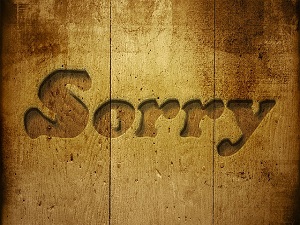The Anatomy of a Good Social Media Apology
Posted by aonenetworks On January 2, 2015 Let’s face it, the people who run and manage businesses are only human. Yes, it’s true, despite rumors to the contrary. As humans, they sometimes make mistakes. Not long ago, DiGiorno, of boxed pizza fame, made such a misstep. A company spokesman, seeing the hashtag #WhyIStayed, quipped “You had pizza.”
Let’s face it, the people who run and manage businesses are only human. Yes, it’s true, despite rumors to the contrary. As humans, they sometimes make mistakes. Not long ago, DiGiorno, of boxed pizza fame, made such a misstep. A company spokesman, seeing the hashtag #WhyIStayed, quipped “You had pizza.”
Under normal circumstances, it would have been funny. After all, pizza’s a pretty good reason to stay, right? Except the hashtag in question was used for cases of domestic violence, and that made it decidedly not funny. Needless to say, the tweet prompted a firestorm of criticism of the company, and rightly so.
The company spokesman was quick to tweet out several apologies, all variations of “Very sorry – I did not read to see what the hashtag was about before posting my reply.” It was earnest and heartfelt, and the company was forgiven, and in that, there are a number of important lessons to be learned.
Lessons Learned
- Accept that your company will, at some point, invariably err. It happens to the best of us, no matter how careful we are.
- When it happens, you must respond. You must move immediately to make amends.
- Your apology needs to be centered around what you did, an acknowledgement that what you did was wrong, and how you mean to correct the mistake going forward so that it does not happen again.
- Building on the above, you cannot play the victim. You cannot post the apology in anger. It must be done professionally and sincerely.
- Understand that even after the apology has been made, you are quite likely to see some backlash. People have been angered by your carelessness, and they’re going to hold your feet to the fire and take you to task for it. When that happens, if you respond to individual barbs at all, it should never be done in anger. It should be on point and on message. The apology needs to be consistently made.
It’s also important that you post the apology on whatever social media channel the insult or mistake was made on. Doing this ensures that the apology reaches the same audience that was offended. It’s perfectly acceptable to post the apology on your company’s blog or website, but this should be in addition to, with links pointing back to, the social media channel where the incident occurred, and not in the place of it.
A good apology can result in forgiveness and the restoration of confidence, both in the company in general and in the brand. A bad, insincere or nonexistent apology can hurt business, as people, seeing that your company can’t even be bothered to acknowledge its mistake, simply opt to vote with their wallets and take their business elsewhere.
Of course, there’s such a thing as too much of a good thing. You don’t want to get in the habit of apologizing for every little thing, because if that’s all you do”¦if your twitter feed or Facebook page turns into nothing but one giant apology tour”¦. then that too, will work against your brand, so a balance must be struck. It’s a fine line, but those companies that manage to navigate it will find themselves in a much better, stronger competitive position than those that do not.





